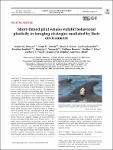Short-finned pilot whales exhibit behavioral plasticity in foraging strategies mediated by their environment
| dc.contributor.author | Shearer, JM | |
| dc.contributor.author | Jensen, FH | |
| dc.contributor.author | Quick, NJ | |
| dc.contributor.author | Friedlaender, A | |
| dc.contributor.author | Southall, B | |
| dc.contributor.author | Nowacek, DP | |
| dc.contributor.author | Bowers, M | |
| dc.contributor.author | Foley, HJ | |
| dc.contributor.author | Swaim, ZT | |
| dc.contributor.author | Waples, DM | |
| dc.contributor.author | Read, AJ | |
| dc.date.accessioned | 2023-11-28T13:21:01Z | |
| dc.date.available | 2023-11-28T13:21:01Z | |
| dc.date.issued | 2022-08-25 | |
| dc.identifier.issn | 0171-8630 | |
| dc.identifier.issn | 1616-1599 | |
| dc.identifier.uri | https://pearl.plymouth.ac.uk/handle/10026.1/21742 | |
| dc.description.abstract |
<jats:p>Predators adapt their foraging behavior to exploit a variety of prey in a range of environments. Short-finned pilot whales are wide-ranging predators in tropical and sub-tropical oceans, but most previous studies of their foraging ecology have been conducted near oceanic islands. We deployed sound- and movement-recording tags on 43 short-finned pilot whales off Cape Hatteras, North Carolina, USA, to measure their foraging behavior in a continental shelf-break ecosystem and investigate how variation in the environment shapes their behavior. Overall, the foraging behavior of pilot whales off Cape Hatteras was similar to that of their counterparts from island-associated habitats. Off Cape Hatteras, pilot whales made foraging dives as deep as 1077 m (mean: 445 m), lasting up to 23 min (mean: 12.8 min), with sprints (pursuit at speeds over 3 m s<jats:sup>-1</jats:sup> and up to 6.9 m s<jats:sup>-1</jats:sup>) in more than half of foraging dives. However, tagged whales off Cape Hatteras produced higher buzz rates (11.3 buzzes dive<jats:sup>-1</jats:sup>), foraged more extensively in daytime hours, and engaged in more frequent benthic foraging than island-associated ecotypes. By parsing the echoic scene generated by the animal’s own echolocation clicks, we show that pilot whales off Cape Hatteras frequently exploit bathymetric features for foraging, with benthic dives resulting in higher prey capture attempts than pelagic dives. The ability of these predators to strategically adapt foraging strategies to local habitat features likely contributes to their ecological success and may allow them to adjust to shifts in prey distributions in a rapidly changing Anthropocene ocean.</jats:p> | |
| dc.format.extent | 1-14 | |
| dc.language | en | |
| dc.publisher | Inter-Research Science Center | |
| dc.subject | 41 Environmental Sciences | |
| dc.subject | 31 Biological Sciences | |
| dc.subject | 3103 Ecology | |
| dc.title | Short-finned pilot whales exhibit behavioral plasticity in foraging strategies mediated by their environment | |
| dc.type | journal-article | |
| dc.type | Journal Article | |
| plymouth.volume | 695 | |
| plymouth.publication-status | Published | |
| plymouth.journal | Marine Ecology Progress Series | |
| dc.identifier.doi | 10.3354/meps14132 | |
| plymouth.organisational-group | |Plymouth | |
| plymouth.organisational-group | |Plymouth|Faculty of Science and Engineering | |
| plymouth.organisational-group | |Plymouth|Faculty of Science and Engineering|School of Biological and Marine Sciences | |
| plymouth.organisational-group | |Plymouth|REF 2021 Researchers by UoA | |
| plymouth.organisational-group | |Plymouth|Users by role | |
| plymouth.organisational-group | |Plymouth|Users by role|Academics | |
| plymouth.organisational-group | |Plymouth|REF 2021 Researchers by UoA|UoA07 Earth Systems and Environmental Sciences | |
| plymouth.organisational-group | |Plymouth|REF 2028 Researchers by UoA | |
| plymouth.organisational-group | |Plymouth|REF 2028 Researchers by UoA|UoA07 Earth Systems and Environmental Sciences | |
| dcterms.dateAccepted | 2022-07-14 | |
| dc.date.updated | 2023-11-28T13:21:01Z | |
| dc.rights.embargodate | 2023-12-6 | |
| dc.identifier.eissn | 1616-1599 | |
| dc.rights.embargoperiod | ||
| rioxxterms.versionofrecord | 10.3354/meps14132 |


